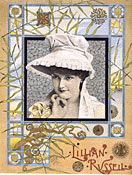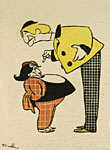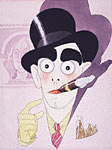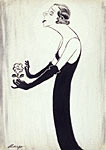
"Red, Hot & Blue: A Salute to American Musicals" showcases the Broadway and Hollywood musical from its immigrant roots in nineteenth-century vaudeville, through its heyday on both the "Great White Way" and the silver screen, to its redefined cultural role today. The exhibition; the title of which is taken from Cole Porter's 1936 Broadway musical Red, Hot and Blue! is a collective biography that spotlights the performers, producers, composers, lyricists, choreographers, set and costume designers, and directors who gave voice and vision to the American experience in the twentieth century.

Street Scene, 1866-1906
Chronicling the "fine romance" between the audience and its musical icons, the exhibition is divided into five major sections.
 The first, "Setting the Stage: Street Scene, focuses on New York's Lower East Side from the 1860s to the turn of the century, when America's emerging musical voice reverberated through the Bowery, lower Broadway, and Union Square.
The first, "Setting the Stage: Street Scene, focuses on New York's Lower East Side from the 1860s to the turn of the century, when America's emerging musical voice reverberated through the Bowery, lower Broadway, and Union Square.
 In the 1870s and 1880s, this ethnic crossroads was a veritable commotion of cultures, with the sound of music cascading in a jumble of minstrel shows, music extravaganzas, opera songs from German beer gardens, Irish brass bands, tinny pianos plunking out sentimental ballads, and curbside Gilbert and Sullivan. In the 1870s and 1880s, this ethnic crossroads was a veritable commotion of cultures, with the sound of music cascading in a jumble of minstrel shows, music extravaganzas, opera songs from German beer gardens, Irish brass bands, tinny pianos plunking out sentimental ballads, and curbside Gilbert and Sullivan. Streetside life nourished a musical theater that spoke for the new American mosaic. The result was a celebration of diverse urban cultures: At his popular music hall, impresario Tony Pastor hosted the liveliest acts of the day, including the Irish-tinged vaudeville routines of Harrigan and Hart, the "Dutch" acts of Weber and Fields, and the minstrelsy of Williams and Walker.
Streetside life nourished a musical theater that spoke for the new American mosaic. The result was a celebration of diverse urban cultures: At his popular music hall, impresario Tony Pastor hosted the liveliest acts of the day, including the Irish-tinged vaudeville routines of Harrigan and Hart, the "Dutch" acts of Weber and Fields, and the minstrelsy of Williams and Walker.

The Rise of the Impresario, 1907-1927
In the second section, "Curtain Up: The Rise of the Impresario," the American musical begins to evolve its own particular character.
  As the entertainment industry became centralized in New York, musical theater developed strong commercial underpinnings. And with the growing emphasis on the business side of the show, impresarios such as Florenz Ziegfeld and the Shubert brothers forged a musical theater dependent on the star system a constellation in the 1910s and 1920s that included Al Jolson, Fanny Brice, Eddie Cantor, and Marilyn Miller.
During the peak 1927-1928 season, Broadway marquees glittered with more than fifty musicals. The milestone that year--one that, by integrating story, music, and character, marked the emergence of the modern American musical--was the Jerome Kern & Oscar Hammerstein II production, Show Boat.
As the entertainment industry became centralized in New York, musical theater developed strong commercial underpinnings. And with the growing emphasis on the business side of the show, impresarios such as Florenz Ziegfeld and the Shubert brothers forged a musical theater dependent on the star system a constellation in the 1910s and 1920s that included Al Jolson, Fanny Brice, Eddie Cantor, and Marilyn Miller.
During the peak 1927-1928 season, Broadway marquees glittered with more than fifty musicals. The milestone that year--one that, by integrating story, music, and character, marked the emergence of the modern American musical--was the Jerome Kern & Oscar Hammerstein II production, Show Boat.

From Broadway to Hollywood, 1927-1942
 At almost the same time, the premiere of the film The Jazz Singer ushered in the era of talkies. Capitalizing on the popularity of Broadway shows, Hollywood soundstages were soon overtaken by a musical mania.
Emphasizing the cultural continuity between stage and screen musicals, "Light the Lights: From Broadway to Hollywood," traces the westward trek of talent, after technology and commerce tilted the entertainment industry toward talking pictures. At almost the same time, the premiere of the film The Jazz Singer ushered in the era of talkies. Capitalizing on the popularity of Broadway shows, Hollywood soundstages were soon overtaken by a musical mania.
Emphasizing the cultural continuity between stage and screen musicals, "Light the Lights: From Broadway to Hollywood," traces the westward trek of talent, after technology and commerce tilted the entertainment industry toward talking pictures. From the Machine Age choreography of Busby Berkeley and the youthful exuberance of Mickey Rooney and Judy Garland to the gossamer grace of Fred Astaire and Ginger Rogers, the silver screen resounded with the words and music of Cole Porter, the Gershwins, and Rodgers and Hart. From the Machine Age choreography of Busby Berkeley and the youthful exuberance of Mickey Rooney and Judy Garland to the gossamer grace of Fred Astaire and Ginger Rogers, the silver screen resounded with the words and music of Cole Porter, the Gershwins, and Rodgers and Hart.
 Broadway and Hollywood, 1943-1959
"The Heights: Broadway and Hollywood," illuminates a golden age, when the American musical was voiced by such stars as Mary Martin, Ethel Merman, and Gene Kelly.  Broadway echoed with the songs of Rodgers and Hammerstein and Lerner and Loewe, while Hollywood soundstages enlarged the screen with Technicolor, Cinemascope, and stereophonic sound.
Musicals in these years evoked two deeply ingrained national impulses: One evinced a nostalgia for a gentler, rural past, as seen in Oklahoma!, Meet Me in St. Louis, and The Music Man; the other exploded with an urban energy in On the Town, Guys and Dolls, and West Side Story. The era when musicals most fully and most optimistically expressed shared tenets of American society ended on a darker note, as the larger culture itself, much like the Sharks and the Jets in West Side Story, rumbled into an era of open conflict. Broadway echoed with the songs of Rodgers and Hammerstein and Lerner and Loewe, while Hollywood soundstages enlarged the screen with Technicolor, Cinemascope, and stereophonic sound.
Musicals in these years evoked two deeply ingrained national impulses: One evinced a nostalgia for a gentler, rural past, as seen in Oklahoma!, Meet Me in St. Louis, and The Music Man; the other exploded with an urban energy in On the Town, Guys and Dolls, and West Side Story. The era when musicals most fully and most optimistically expressed shared tenets of American society ended on a darker note, as the larger culture itself, much like the Sharks and the Jets in West Side Story, rumbled into an era of open conflict.

Redefinition and Revival, 1960-Present
Years of enormous cultural and social change have clearly affected the American musical: the vast middle class, mainstream audience that had always supported the musical dissolved, and without any center, musicals became as fragmented as the rest of American culture. The final section, "Side by Side by Side: Redefinition and Revival, & Present," shows the form and function of musicals in this age of contradictions. Musicals such as Hair have redefined themselves to incorporate the multiplicity and diversity of American life; at the same time, a standard repertoire of American musical classics has emerged, with revivals like the 1994 Show Boat seeking a circularity with mythic or traditional themes in American culture.
Although musical theater continues to reconfigure itself, the essential core of the American musical remains with its past. No matter how extravagantly refashioned, there is a ghost-in-the-machine quality to modern musical theater that, while thoroughly contemporary, harkens back to its origins to earlier images flickering on a Vitascope screen, raspy voices rolling out of Victrolas, and silvery figures dancing across a Bakelite set. Amy Henderson
Dwight Blocker Bowers
Exhibition dates: October 25, 1996 through July 6, 1997
This exhibition, jointly organized by the National Portrait Gallery and the National Museum of American History, was sponsored by Discover Card. Additional support was provided by The Shubert Foundation, the Ira and Leonore Gershwin Philanthropic Fund, Hal and Judy Prince, and the Smithsonian Institution Special Exhibition Fund. In-kind support was provided by Red Hot & Blue Limited Partnership.
|









